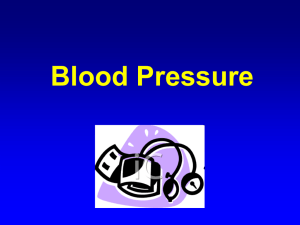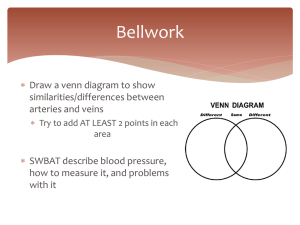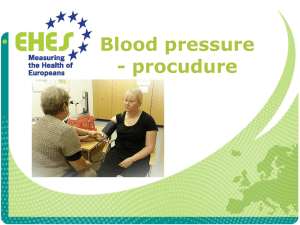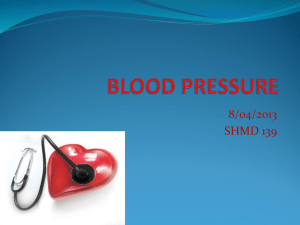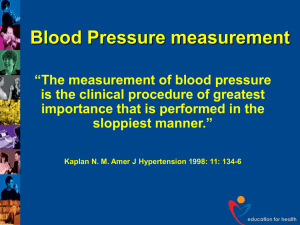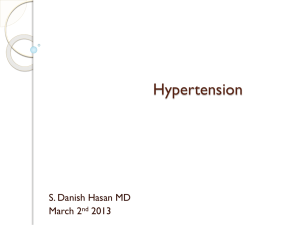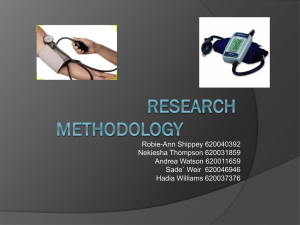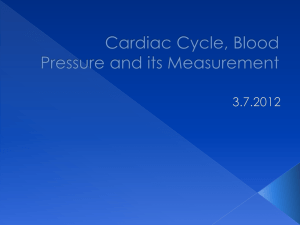MEASURING AND RECORDING BLOOD PRESSURE
advertisement
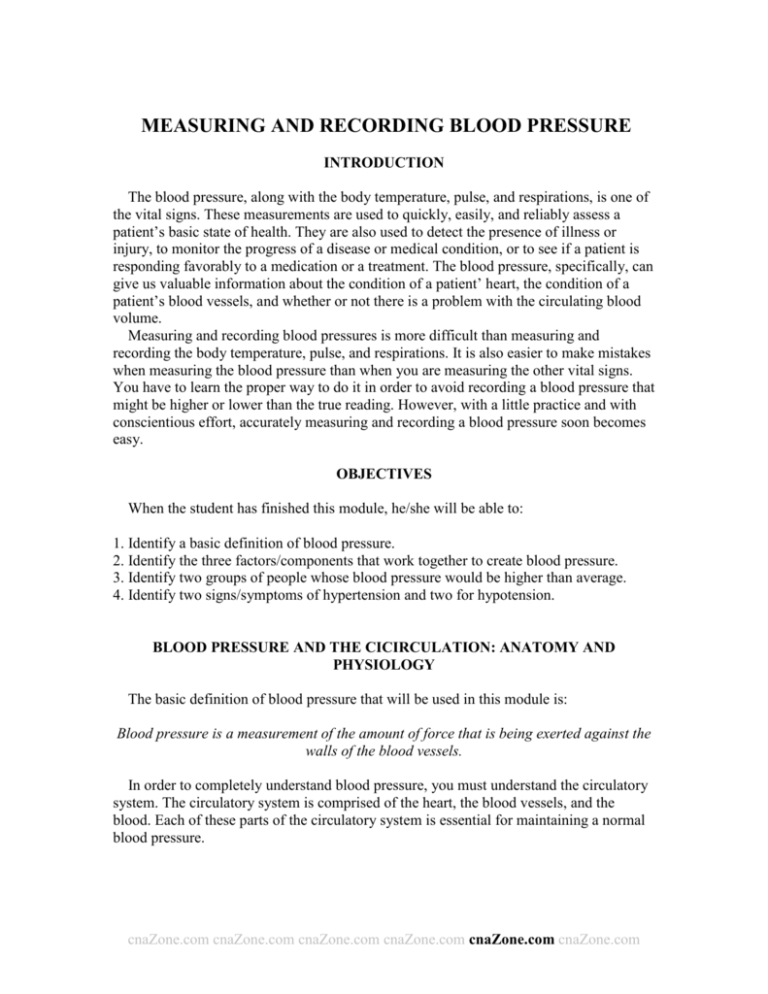
MEASURING AND RECORDING BLOOD PRESSURE INTRODUCTION The blood pressure, along with the body temperature, pulse, and respirations, is one of the vital signs. These measurements are used to quickly, easily, and reliably assess a patient’s basic state of health. They are also used to detect the presence of illness or injury, to monitor the progress of a disease or medical condition, or to see if a patient is responding favorably to a medication or a treatment. The blood pressure, specifically, can give us valuable information about the condition of a patient’ heart, the condition of a patient’s blood vessels, and whether or not there is a problem with the circulating blood volume. Measuring and recording blood pressures is more difficult than measuring and recording the body temperature, pulse, and respirations. It is also easier to make mistakes when measuring the blood pressure than when you are measuring the other vital signs. You have to learn the proper way to do it in order to avoid recording a blood pressure that might be higher or lower than the true reading. However, with a little practice and with conscientious effort, accurately measuring and recording a blood pressure soon becomes easy. OBJECTIVES When the student has finished this module, he/she will be able to: 1. Identify a basic definition of blood pressure. 2. Identify the three factors/components that work together to create blood pressure. 3. Identify two groups of people whose blood pressure would be higher than average. 4. Identify two signs/symptoms of hypertension and two for hypotension. BLOOD PRESSURE AND THE CICIRCULATION: ANATOMY AND PHYSIOLOGY The basic definition of blood pressure that will be used in this module is: Blood pressure is a measurement of the amount of force that is being exerted against the walls of the blood vessels. In order to completely understand blood pressure, you must understand the circulatory system. The circulatory system is comprised of the heart, the blood vessels, and the blood. Each of these parts of the circulatory system is essential for maintaining a normal blood pressure. cnaZone.com cnaZone.com cnaZone.com cnaZone.com cnaZone.com cnaZone.com The heart: The heart is a muscular pump that is divided into four chambers. It beats rhythmically, with an equal amount of time between each beat. For the average adult, the normal heart rate is approximately 72 beats a minute, and the normal range is 60-100 beats a minute. There are two phases to a heart beat. The first phase is diastole. In this first phase, the chambers of the heart fill with blood. The second phase is systole. In this second phase, the chambers of the heart forcefully contract and pump a volume of oxygenated blood out to the body through the blood vessels. The oxygenated blood is delivered to the tissues and organs, and it is then unoxygenated blood is returned to the heart The blood vessels: The arteries and the capillaries carry oxygenated blood from the heart to the organs and tissues. After the oxygen has been released to them, the veins carry unoxygenated blood and metabolic waste products byproducts mostly carbon dioxide - back from the body to the lungs. The carbon dioxide is eliminated from the blood when we exhale, and then oxygen is delivered to the blood when we inhale. The oxygenated blood is delivered to the heart and the cycle starts again. It is important to know that the arteries, capillaries, and veins are strong and have muscular tone (Note: the veins less so than the arteries ad the capillaries). When the heart pumps a wave of blood out to the circulation, the blood vessels expand to accommodate the increased volume, but because they have muscular tone/tension, they also contract down in response and that moves the blood along and out through the body. Systole, the second phase of a heart beat, is strong enough to send a volume of blood out through the arteries. But systole is not strong enough to send that volume of blood from the heart, out to the body and back to the heart. The muscular tone of the blood vessels must be maintained or blood pressure would fall below the normal limit. The blood: The blood volume for an average adult is approximately five liters: five liters is approximately 1.3 gallons. Blood volume slightly more in men than it is in women. As explained above, blood carries oxygen to the body and carbon dioxide from the body to the lungs. The purpose of the circulatory system is to circulate blood through the body, and the following are the basic steps of this process 1. Oxygen combines with blood that is circulating through the blood vessels of the lungs - the pulmonary circulation. The oxygen is delivered to the pulmonary circulation when we inhale. 2. The oxygenated blood in the lungs is delivered to heart. 3. The heart pumps the oxygenated blood out to the organs and tissues and then back again through the blood vessels: the arteries, the capillaries and the veins. 4. Oxygen is delivered to the body, and then carbon dioxide moves from the tissues and organs into the blood. 5. The unoxygenated blood that is carrying carbon dioxide is circulated back to the lungs. cnaZone.com cnaZone.com cnaZone.com cnaZone.com cnaZone.com cnaZone.com 6. When the unoxygenated blood reaches the lungs, the carbon dioxide is eliminated when we inhale, oxygen is delivered when we inhale and the process begins again. If you think of the circulatory system and all of its components, the heart, the blood vessels, and the blood, as a closed system, it is easy to see how all three of these are needed for the blood pressure. Without a strong, functioning heart, the blood would not move through the circulation. Without healthy, functioning blood vessels, the initial wave of pressure that is created by systole would not be strong enough or last long enough for the blood to reach the extremities, the deep organs, and tissues and return back to the heart. And without a normal blood volume, the closed system would obviously be empty and there would be no pressure at all. In order to maintain blood pressure there must be: 1) A normal, functioning heart; 2) Normal, healthy blood vessels, and; 3) A normal volume of blood. These points cannot be stressed enough. If a patient’s blood pressure is abnormally high or abnormally low, there is a problem with one of these three. In the beginning of this section, blood pressure was defined as the measurement of the amount of force that is being exerted against the walls of the blood vessels. You can see however that this force/pressure varies. It rises when the heart pushes out a volume of blood (imagine squeezing on a tube of toothpaste with the cap closed; the pressure inside the tube will go up) and then it goes back down to a steady state that represents the pressure inside the blood vessels between each heartbeat. Blood pressure is defined as the measurement of the force pressure exerted against the walls of the blood vessels. But as mentioned above, blood pressure rises sharply during each heartbeat and there is also a steady state of pressure in the blood vessels between each heartbeat. The first of those two pressures, the pressure in the blood vessels as the heart is contracting, is called the systolic pressure. The second pressure, the steady state pressure in the blood vessels between heart beats, is called the diastolic pressure. When you measure someone’s blood pressure you are checking the systolic and diastolic pressures and both of them are very important. Some people, when asked what a patient’s blood pressure is, will only report the systolic but this is incorrect. The diastolic pressure reflects the constant pressure in the circulatory system, and it provides key information about how well the body is being supplied with blood. Make sure you notice and record both the systolic and the diastolic pressures. MEASURING AND RECORDING BLOOD PRESSURE In order to measure a blood pressure, you will need a stethoscope and a blood pressure monitor. (Note: The systolic blood pressure can be measured without a stethoscope by a method called palpation, but that will not be covered in this module). The technical term for a blood pressure monitor is sphygmomanometer, but they are more commonly called blood pressure cuffs. They can use mercury or they can be mechanical (the mechanical ones are also called aneroid cuffs). Digital blood pressure cuffs are also commonly used. cnaZone.com cnaZone.com cnaZone.com cnaZone.com cnaZone.com cnaZone.com These simply require that the blood pressure monitor be attached to the person; the machine does all the measuring. Both the mercury and the mechanical sphygmomanometers have an inflatable cuff. With a mercury blood pressure apparatus, the cuff is attached with a rubber tube to a vertical glass tube that is filled with mercury and has gradations imprinted on it. An aneroid sphygmomanometer also has a rubber tube that is attached to the cuff, but this tube is attached to a gauge with a moveable needle, much like the face of a clock. Learning Break: The blood pressure can also be checked in the wrist using a regular sphygmomanometer or a blood pressure cuff designed for that purpose. When this is done you are measuring the pressure in the radial artery, the same blood vessel used to check pulse rate. Measuring blood pressure in the wrist may be necessary if the properly sized cuff for a particular patient is not available or for some other reason. However, measuring the blood pressure at the wrist using a sphygmomanometer or one of these special cuffs will usually result in a reading that is higher than if the pressure was measured in the upper arm. Also, the wrist blood pressure cuffs are very sensitive and must be used correctly or the readings will be inaccurate. With both the mercury and the aneroid sphygmomanometer, another rubber tube is also attached to the cuff and at the end of that tube is a rubber bulb, and the rubber bulb is used to inflate the cuff. Once you have your stethoscope and a sphygmomanometer you are ready to begin. In order to make sure the blood pressure you record is accurate, keep these points in mind: The patient should be lying down or sitting. If the blood pressure is taken when the patient is standing, the measurement will be too low. Remember, you are measuring the pressure at a particular point in a closed system. When someone is standing, it is more difficult for the heart and the blood vessels maintain a blood pressure because they are working against gravity, so to get an accurate blood pressure the patient must be lying down or sitting. Choose either arm to use, but do not measure the blood pressure in an arm in which there is an intravenous needle, a hemodialysis shunt, or any other type of vascular access device. Do not take the blood pressure in an arm that has been injured. A woman who has had a breast removed should have her blood pressure taken in the arm opposite the side of the surgery. Make sure the arm is level with the heart; this is very important. If the arm is above the level of the heart, the blood pressure reading will be falsely low. If the arm is below the level of the heart, the blood pressure reading will be falsely high. Have the patient move his/her clothing up the arm, towards the shoulder, until there is room for the blood pressure cuff. Do not take someone’s blood pressure with the cuff placed over a shirt, sweater, etc. The patient should be relaxed and ideally, he/she should be in the sitting or lying position for at least two minutes before the blood pressure is checked. The cuff should be the proper size. A cuff that is too big will result is a reading that is falsely low, and a cuff that is too small will result in a reading that is falsely high. The cuffs have demarcations on them that will help you determine cnaZone.com cnaZone.com cnaZone.com cnaZone.com cnaZone.com cnaZone.com which size to use. For the majority of patients, there is a standard sized cuff that will be appropriate. There should be several different sizes of cuffs available so that people who are very thin or who are obese can be accommodated. Try and measure the blood pressure in a place where there is a minimum of background noise. Now you are ready to measure the blood pressure. Have the patient hold his/her arm out straight with the palm of the hand facing upward. Wrap the cuff around the patient’s arm securely. It should be placed so that the edge of the cuff is one inch above the bend of the elbow. Next, find the brachial artery: this is the blood vessel that will be used to determine the blood pressure. The brachial artery is located on the arm on the left side of the fold of the elbow - towards the center of the patient’s body. Use your fingers, not your thumb, to palpate the area until you can feel the pulse. When you have found the pulse, put your stethoscope over that spot. Next, close the valve that is attached to the rubber bulb and begin squeezing. You will see the column of mercury rise in the tube or the needle of the aneroid sphygmomanometer move. Keep inflating the cuff until the mercury level or the needle on the aneroid gauge is at 160: this is a reasonable point to begin. When the level of 160 has been reached the brachial artery will be completely occluded, and you should not hear anything through the stethoscope. Slowly open the valve. The mercury column or the needle will start to drop. Remember to open the valve slowly: if the air is let out of the cuff too quickly, you won’t be able to measure the blood pressure correctly. Keep your eyes focused closely on the mercury or the needle on the gauge. The proper amount of time to deflate the cuff is 2 mm Hg a second. If the cuff is deflated too quickly, the systolic blood pressure will be read as too low and the diastolic pressure will be read as too high. After a few seconds, you will begin to hear the sound of the pulse through your stethoscope and you will be able to see the column of mercury or the needle on the aneroid sphygmomanometer move back and forth at the same time as they are dropping: each movement of the mercury column or the aneroid needle represents a heart beat. That point at which you see that movement is the systolic blood pressure. In a few more seconds, there will be a point at which you will no longer hear the pulse or see the mercury column or the needle moving back and forth; that point is the diastolic blood pressure. Let the cuff deflate completely, remove it and you are done. If you notice from the patient’s chart that the systolic pressure when last measured was over 160, inflate the cuff a bit higher. Also, if you inflate the cuff to 160, but you immediately hear the patient’s pulse, deflate the cuff, wait a bit, and then inflate the cuff a bit higher. By convention, blood pressure is recorded using units called millimeters of mercury: this is often recorded using the abbreviation mm Hg (mm stands for millimeters, and Hg is the chemical symbol for mercury). You should record the blood pressure immediately after you have measured it and make a notation that indicates whether the patient was lying or sitting at the time. By tradition, the blood pressure is recorded with the systolic pressure first, a forward slash, and then the diastolic pressure, for example, 126/68. cnaZone.com cnaZone.com cnaZone.com cnaZone.com cnaZone.com cnaZone.com Learning Break: You may see someone measuring blood pressure and pulse when the patient is lying down, sitting, and then when standing. These measurements are also done with timed intervals between the readings. This procedure is called checking postural vital signs, and it is often used to determine whether or not the patient is dehydrated or is bleeding. Checking postural vital signs will not be discussed in this module. WHAT IS A NORMAL BLOOD PRESSURE? There have been many attempts to determine a definition of a normal blood pressure. But it is not really possible to provide a single number or a range that can be always be considered normal; there are simply too many variations in blood pressure among the general population for this to be practical and accurate. The blood pressure of many women, some elderly people, people who are very thin, and people who are very athletic is typically at the lower end of the normal range. The blood pressure of children and infants is lower than the blood pressure of adults. The blood pressure of people who are obese, people of certain ethnic groups such as African-Americans, and many elderly people is likely to be at the higher end of the normal range. And blood pressure, like temperature and pulse, varies depending on the time of day. It is typically higher during the day and lower during the evening hours and the early morning. However, most authorities agree that instead of looking for a blood pressure that can be defined as normal, it is more useful to think of what blood pressure means and what effects a high or low blood pressure can have on health. If blood pressure is considered that way, then a normal blood pressure is a pressure that can be safely maintained over the course of your life. And an abnormal blood pressure is a pressure that is potentially harmful to you because it can cause adverse health effects. A blood pressure that is abnormally high is typically a chronic condition that exists for many years, although there are some acute conditions that cause sudden, dangerous elevations of blood pressure. A blood pressure that is abnormally low is typically caused by an acute medical problem. In either situation, there can be serious consequences if the blood pressure is not stabilized. So the parameters of “normal” are a bit arbitrary and flexible, but in this module, a normal blood pressure will be defined as a systolic pressure less 120 mm Hg and/or a diastolic pressure less than 80 mm Hg. The blood pressures of infants and children are lower than those of adults. Blood Pressure: Normal Ranges for Infants, Children and Adolescents Newborn: 65/50 2 months: 85/50 4 months: 90/50 6 months 90/55 1 year: 100/55 2 years: 102/58 4 years: 104/65 6 years 107/69 10 years: 115/74 12 years: 119/76 16 years: 120/80 cnaZone.com cnaZone.com cnaZone.com cnaZone.com cnaZone.com cnaZone.com Errors in Measurement If the patient’s blood pressure is too high or too low, but the patient has no complaints and she/he appears comfortable then it is likely that some error is technique has been made. Make sure that that the patient has been resting comfortably for at least five minutes. Is the cuff the correct size? If the cuff is too small, the blood pressure will be too high, and if the cuff is too large the blood pressure will be too low. Was the cuff deflated too quickly? Check to see if the patient’s arm was placed at the level of the heart. Is the stethoscope placed over an article of clothing, e.g., a shirt or sweater sleeve? Ask the patient if he/she is feeling anxious or stressed. The patient may be upset but it may not be obvious. Has the patient just recently exercised, drank a cup of coffee, or taken a medication that may elevate he blood pressure? If someone’s blood pressure is too high or too low and you have determined that there were no error in technique and no other reason for the abnormal reading, wait five minutes and check the blood pressure again. If the reading is still abnormal, it must be assumed that the blood pressure is too high or too low and an RN or your immediate supervisor should be notified. BLOOD PRESSURES OUTSIDE THE NORMAL RANGE: HYPERTENSION AND HYPOTENSION You will often be measuring blood pressures that will be outside the normal range. There are many conditions can cause blood pressure to be too high or too low. Some of the more common ones are: Hypertension (Abnormally high) Blood loss (Abnormally low) Infection (Abnormally low: the blood vessels have dilated in response) Myocardial infarction (Abnormally low) Drug overdose (Abnormally high as with cocaine, or abnormally low, as with narcotics) Adverse drug reaction (Abnormally high or low) Dehydration (Abnormally low) You should keep in mind that what might be a normal blood pressure for one person would be considered abnormally high or low for someone else. For example, a young, slender, athletic woman may have a blood pressure of 98/ 48 mm Hg. This reading is on the lower end of the normal range, but it is still normal for someone of her age, gender, cnaZone.com cnaZone.com cnaZone.com cnaZone.com cnaZone.com cnaZone.com and life style. However, a reading of 98/48 mm Hg may indicate that something is wrong if the patient normally has a blood pressure of 139/78 mm Hg and that patient is 78 years old, obese, and sedentary. And the opposite is certainly true, also. If someone normally has a blood pressure of 98/48 mm Hg and now has a pressure of 139/78 mm Hg that may be a cause for concern. In either situation, these changes should prompt your attention. Leaning Break: If the patient’s blood pressure is unusually high or low when compared what it has been before, make sure you tell an RN or your immediate supervisor immediately. The most common cause of an elevated blood pressure is hypertension. There are many causes of hypotension, but it usually simple to determine why the blood pressure is low. Hypertension Hypertension is defined as a systolic blood pressure greater than 140 mm Hg or a diastolic blood pressure greater than 90 mm Hg. Hypertension is a very common. Approximately 75 million Americans have hypertension, and it is considered to be a major contributing risk factor for the development of coronary artery disease, kidney disease and stroke. In approximately 95% of all cases hypertension there is no identifiable cause. These cases are called primary hypertension, and they are most likely due to a genetic predisposition to the disease. There are some endocrine, renal, and vascular problems that can cause hypertension, but these are relatively rare. Hypertension affects men more than women until the age of 45; after that point, both genders are equally affected. In the United States, there is a higher incidence of hypertension in African Americans than in any other ethnic group. The diagnosis of hypertension is usually made by a matter of chance when someone has her/his blood pressure checked during a routine physical exam. This is not surprising as blood pressure can be elevated and elevated considerably for years without producing any signs and or symptoms. Once an initial reading of over 140 mm Hg or over 90 mm Hg has been made, it is recommended that these readings be confirmed in order to be sure that the elevations noted on the exam were not an isolated incident. Confirmation should be done by checking the blood pressure on three or more separate occasions, each occasion separated by at least several days. During these visits, great care should be taken to ensure that the readings are accurate, e.g., make sure that patient has rested for at least five minutes, choose the right size cuff, etc. Three readings should be obtained, each reading separated by at least five minutes. The average of the three is used as the true value and if the average is greater than 140 mm Hg or 90 mm Hg, the patient has hypertension. Once the diagnosis of primary hypertension has been made, the patient will be checked for damage to the blood vessels, eyes, heart, and kidneys, as these are organs and structures that are typically affected by the long-term elevation of blood pressure. The higher the blood pressure and the longer it has been elevated, the great the risk is for complications. cnaZone.com cnaZone.com cnaZone.com cnaZone.com cnaZone.com cnaZone.com Treatment of hypertension begins with life style changes. The patient will be advised to eat a low-salt, low fat diet, engage in aerobic exercise, limit alcohol intake, lose weight, and stop smoking. If these life style changes are not successful or the patient cannot comply with them, anti-hypertensives are the next step. There are situations in which a patient’s blood pressure is elevated and the patient is symptomatic. Hypertensive emergencies occur when the patient’s systolic blood pressure is greater than 180 mm Hg or diastolic pressure is greater than 120 mm Hg and the patient has clear evidence of organ damage such as blurred vision, chest pain, or confusion. Obviously, these situations should be brought to the immediate attention of a physician so if the patient’s systolic blood pressure is greater than 180 mm Hg or the diastolic blood pressure is greater than 120 mm Hg, report this immediately to an RN or your immediate supervisor. Also, ask the person if he/she is experiencing any dizziness, headaches, blurred vision, or chest pain. Learning Break: However, if a person with a history of hypertension is complaining of blurred vision, chest pain, dizziness, or headache, report this immediately to the RN or your immediate supervisor, regardless of what the blood pressure measurement might be. Hypotension Hypotension will be defined in this module as a systolic blood pressure less than 90 mm Hg or a diastolic blood pressure less than 60 mm Hg. Most people are aware of the dangers of hypertension, but hypotension is also a cause for concern as it can have serious consequences. The body requires a sufficient supply of blood to function properly, and the driving force of the blood pressure delivers that volume of blood. Any organ or body structure will suffer without an adequate supply of blood. But the brain, the heart, and the kidneys are especially vulnerable because they are so metabolically active and each one has such a large number of blood vessels. So if the blood pressure is too low, the patient can have a stroke, heart attack, or damage to the kidneys. There are too many causes of hypotension to list and discuss them all, but the most common ones would be: Dehydration Hemorrhage Infection Myocardial infarction, a.k.a., heart attack Each one of these causes of hypotension clearly illustrates how maintenance of a normal blood pressure depends on a strong, functioning heart, an adequate blood volume, and good muscular tone of the blood vessels. Example #1: Dehydration or hemorrhage: If someone is dehydrated or he/she is hemorrhaging, the volume of the closed system is compromised. The circulatory system can try and compensate by increasing the pulse rate and by having the heart beat more cnaZone.com cnaZone.com cnaZone.com cnaZone.com cnaZone.com cnaZone.com forcefully, but if the volume in the system is too low these compensatory mechanisms will not work. Example #2: Infection can, at times, be so overwhelming that the blood vessels become very, very dilated. (Note: these patients are often dehydrated, as well) This widespread vasodilation happens quite often in a condition called septic shock. As with dehydration and hemorrhage, compensatory mechanisms may not be enough to restore and maintain a normal blood pressure. Example# 3: Myocardial infarction causes damage to the heart muscle, and the heart is then not strong enough to pump out blood to the body. Unlike someone who has hypertension, the patient who is hypotensive often has some very dramatic signs and symptoms. These could include: chest pain, confusion, cool/clammy skin, cyanosis, diaphoresis, difficulty breathing, dizziness, fainting, headache, lethargy, lightheadedness, pallor, palpitations, tachycardia, tachypnea, weakness. The first signs of hypotension are often feelings of dizziness and weakness when the patient moves from a lying or sitting position to standing. What should you do if someone is hypotensive? The first thing to do is to make sure the patient is in a safe position. Hypotension can cause fainting or loss of consciousness and lead to a fall, so place the patient supine; if that is not possible have the patient sit down. Lying or sitting will help keep the patient safe, and it will also help prevent the blood pressure from going lower. Next, notify an RN or your immediate supervisor and also make a quick assessment of the patient. Check her/his pulse and respirations and if there is time, check the temperature. Look at the color of the skin, and check the skin for cyanosis, diaphoresis, or pallor. Check the patient’s neurological status - is the patient confused, slow to respond - and be sure to ask the patient if he/she is having any symptoms. SUMMARY Measuring and recording blood pressure quickly and correctly takes more time to learn and to do correctly than measuring the other vitals signs, but it is not a highly difficult skill to master. The important points to remember are: Blood pressure is a measurement of the amount of force that is being exerted against the walls of the blood vessels. When you are measuring blood pressure, you are measuring the systolic pressure and the diastolic pressure. The systolic pressure represents the force exerted against the walls of the blood vessel during a heart beat. The diastolic pressure represents the steady state pressure that is exerted against the walls of the blood vessels between each heart beat. A normal blood pressure is defined as a systolic pressure less than 120 mm Hg and a diastolic pressure less than 80 mm Hg. cnaZone.com cnaZone.com cnaZone.com cnaZone.com cnaZone.com cnaZone.com Hypertension is defined as a systolic pressure greater than over 140 mm Hg and/or a diastolic pressure greater than 90 mm Hg. Hypotension is defined as a systolic pressure less than 90 mm Hg and/or a diastolic pressure less than 60 mm Hg. An abnormally high or low blood pressure would be caused by a derangement in the heart, the blood vessels or the circulating blood volume. The most common cause of an elevated blood pressure is primary hypertension. The most common causes of hypotension are dehydration, hemorrhage, infection, and myocardial infarction. In order to measure the blood pressure accurately, the patient should be sitting or lying, should be at rest for at least two minutes, and the patient’s arm must be level with the heart. You should notify someone immediately if the patient’s blood pressure is abnormally high or low or if it is abnormally high or low compared to previous readings for that patient. You should also notify someone immediately if the patient has hypertension and is complaining of blurred vision, chest pain, dizziness, or headache, regardless of whether or not the blood pressure at the time is normal. cnaZone.com cnaZone.com cnaZone.com cnaZone.com cnaZone.com cnaZone.com
